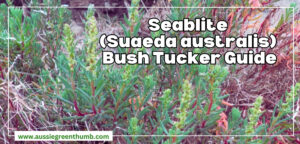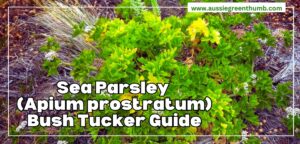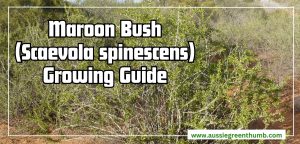In this comprehensive guide, I will be covering my 30 best types of eucalyptus trees to grow in Australia as well as look at their lifespans, growing needs, and some gardening tips so you can find the perfect Eucalyptus species for your outdoor spaces.
More...
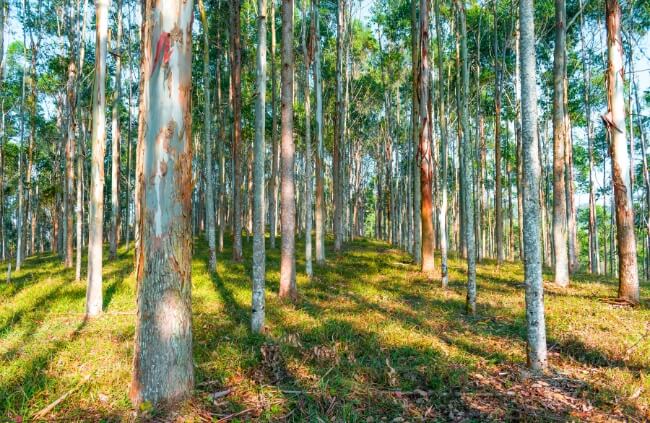
I believe we are truly spoilt for choice with a vast selection of many stunning types of eucalyptus plants in Australia. Commonly known as gum trees, eucalypts are undoubtedly some of our most iconic Australian trees and shrubs.
The Eucalyptus genus consists of almost 900 different species, most of which are native to Australia and are the primary food of koalas.
Today, they are popular choices for garden enthusiasts globally, sporting beautifully textured barks, aromatic leaves, and elegant structures. It’s easy to see why so many people are captivated by their charm.
Each species offers unique characteristics that will suit certain landscaping applications best. In addition, some Eucalyptus species live for only 30 years while others can live up to 300 years so it’s important to know which species is best for your gardening needs.
30 Types of Eucalyptus Trees to Grow in Australia
1. River Red Gum – Eucalyptus camaldulensis
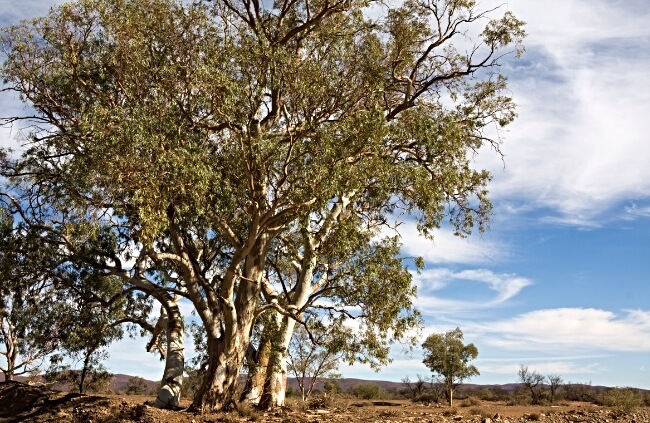
Eucalyptus camaldulensis, commonly known as red gum tree is one of the most cultivated eucalyptus plant and features notoriously twisted branches and is often located growing near water across the country.
This eucalyptus trees provide vital shade for kangaroos in their native habitat and today, they are popular picks for large gardens thanks to their beautiful cream-coloured bark that is variegated in pops of pinks, yellows, and browns.
- Native Area: Most of mainland Australia
- Size: Up to 30 metres tall and 20 metres wide
- Lifespan: 200-500 years
- Uses: Roadside, backyard
- Growing Conditions: Prefers full sun to light shade planted in moderately fertile soil.
- Maintenance: Water well during extended dry periods and apply organic mulch around the base in summer to help with soil moisture retention.
2. Caesia Gum Tree – Eucalyptus caesia
A highly ornamental and very popular small tree that produces fluffy pink flower clusters at branch tips, all elevated by the tree's lovely smooth grey bark.
The ‘Silver Princess’ cultivar is also stunning small tree and is considered one of the best Eucalyptus species to grow in containers.
- Native Area: Southwest of Western Australia
- Size: 5 to 8 metres tall, 3 to 4 metres wide
- Lifespan: 50 to 150 years
- Uses: Small feature trees
- Growing Conditions: Loves plenty of sunlight and loamy soil that drains well.
- Maintenance: Water deeply during dry spells and mulch around the base in summer.
3. Yellow Gum – Eucalyptus leucoxylon
Eucalyptus leucoxylon, common known as yellow gum, is a medium-sized tree that sports reddish-pink fluffy flowers and a smooth grey bark and branches. This woodland tree is great for more humid climates, but it doesn’t tolerate fully tropical conditions like other eucalyptus plant.
- Native Area: South Australia and Central Victoria
- Size: Up to 15 metres tall and 10 metres wide
- Lifespan: 50 to 150 years
- Uses: Backyard shade tree
- Growing Conditions: Full sun to dappled shade is best, planted in well-drained soil.
- Maintenance: Water deeply during dry spells and protect from cold winds when young.
4. Tasmanian Blue Gum – Eucalyptus globulus
One of the favourite white flowering eucalyptus tree, Eucalyptus globulus or commonly known as Southern blue gum, produces highly fragrant elliptical leaves that gently droop and sway with the wind.
The fluffy white blooms are borne in small clusters from summer to early autumn that the blue gum tree canopy is spreading, perfect for adding pops of shade around the garden.
- Native Area: Tasmania and southeastern Australia
- Size: Up to 55 metres tall and 15 metres wide
- Lifespan: 50 to 150 years
- Uses: Backyard shade tree or feature specimen
- Growing Conditions: Plant in full sun to partial shade in sandy-loam soil.
- Maintenance: Water blue gum well when young and fertilise with a slow-release fertiliser annually.
5. Red Ironbark Gum – Eucalyptus sideroxylon
The red ironbark is a proud ornamental woodland tree that produces pink powder puff flowers. It has a strong upright form with weeping branches.
Its scented leaves are long and narrow, growing in dense cascades around flower clusters.


Get Your Free Guide:
Master Growing Australian Natives eBook
A Must Have Complete Guide for Every Australian Garden
Get Your Free Guide:
Master Growing Australian Natives eBook
A Must Have Complete Guide for Every Australian Garden
- Native Area: Victoria, NSW, and Queensland
- Size: 20 to 30 metres tall, 10 to 15 metres wide
- Lifespan: 30 to 50 years
- Uses: Backyard tree for large gardens
- Growing Conditions: Plant in full sun to part shade in slightly acidic sandy-loam soil.
- Maintenance: Water regularly while young and only fertilise if the soil lacks nutrients.
6. Manna Gum – Eucalyptus viminalis
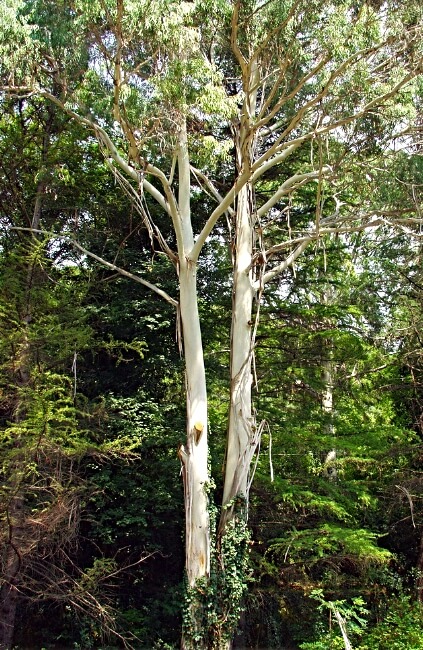
Also known as the manna gum, this eucalyptus tree is notorious for its beautiful white and smooth bark that encompasses the entire tree. The main trunk forms from a lignotuber with the branches growing in an attractive upright habit. Lignotubers are common in many eucalyptus plant.
- Native Area: NSW and some of Victoria
- Size: 20 to 50 metres tall, up to 10 metres wide
- Lifespan: 500+ years
- Uses: Ornamental feature tree
- Growing Conditions: Prefers full sun in moist fertile soil.
- Maintenance: Water and fertilise well in spring to encourage blooms and foliage.
7. Yellow Box – Eucalyptus melliodora
A key species in many Australian ecosystems, the yellow box gum is another popular tree when looking at eucalyptus plant thanks to its gorgeous oval-shaped canopy.
Its nectar is sweet and highly nutritious to bees, owing to the tree's secondary name, the honey box.
- Native Area: Southeastern continental Australia
- Size: Up to 30 metres tall and 25 metres wide
- Lifespan: 300 to 500 years
- Uses: A great shade tree for street or garden plantings
- Growing Conditions: Adaptable to different soil types but requires a sunny spot.
- Maintenance: Water occasionally during dry spells and mulch with organic matter.
8. Mountain Ash – Eucalyptus regnans
Standing tall and proud, mountain ash is considered as the tallest known flowering plant. It features a straight trunk with smooth bark and dense fern-like foliage that adds lovely texture to outdoor spaces.
Its form is tall but slender, perfect for gardens that need some height and structure. It has an open crown and slender leaves and branches out broadly.
- Native Area: Victoria and Tasmania
- Size: 70 to 120 metres tall, up to 20 metres wide
- Lifespan: Average lifespan of 400 years
- Uses: Makes for an elegant and dramatic feature in large gardens
- Growing Conditions: Needs full sun and good humidity to thrive.
- Maintenance: Water and mulch well during droughts.
9. Snow Gum – Eucalyptus pauciflora
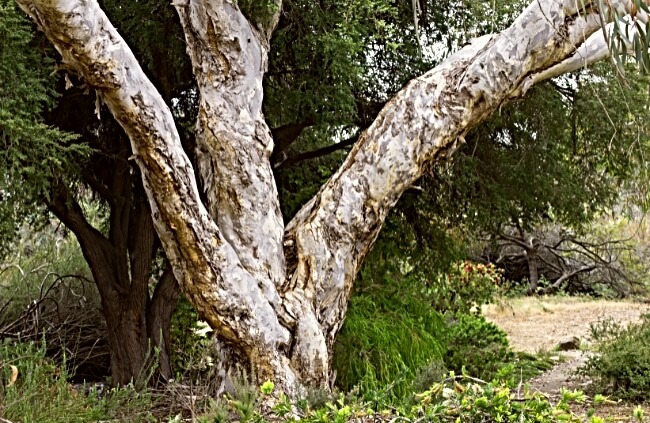
Ideal for cold climates as its common name suggests, this stunning and hardy eucalypt produces a smooth bark that is variegated in creamy greys and greens, with ample clusters of delicate white flowers.
Snow gum too grows from a large lignotuber with dramatic branches that spread outwards, giving this eucalyptus tree an appealing rounded form overall.
- Native Area: Southeastern Australia
- Size: Up to 30 metres tall and wide (‘Mount Buffalo’ is a fantastic dwarf variety)
- Lifespan: 30 to 60 years
- Uses: Makes for an excellent windbreak for farms or larger landscapes
- Growing Conditions: Prefers full sun planted in neutral to slightly acidic moist soil.
- Maintenance: Needs protection from strong winds and regular fertilising while young.
10. Cider Gum – Eucalyptus gunnii
One of the most iconic type of eucalyptus tree for home landscaping, Eucalyptus gunnii boasts a stunning silver bark paired with large chrome-green clouds of foliage that shimmer and teem with wind movements, offering gardens a lovely sparkling touch.
Cider gum can be grown as a single-stemmed tree with pruning or can be left to open its limbs and take on a multi-stemmed form. It can also be grown well in containers.
- Native Area: Central Tasmania
- Size: Up to 35 metres tall and 12 metres wide
- Lifespan: Up to 150 years old
- Uses: A great decorative tree for shade, windbreak, or screening
- Growing Conditions: Needs a bright sunny spot planted into enriched well-drained soil.
- Maintenance: Mulch in spring and water well while developing.
11. Messmate Stringybark – Eucalyptus obliqua
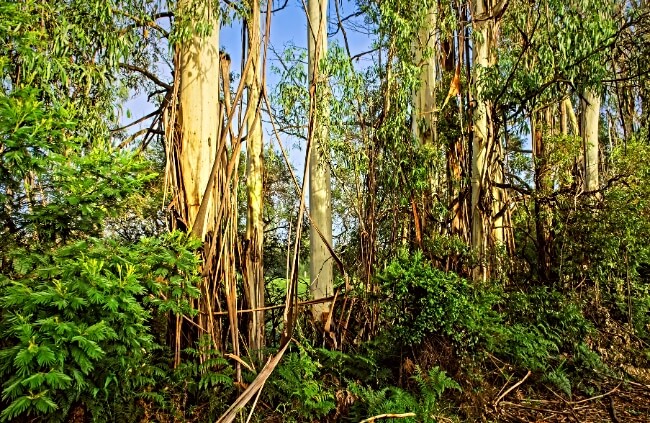
With its thick and stringy bark that extends from the trunk to the branchlets, Eucalyptus obliqua certainly offers texture to outdoor spaces. One of the best eucalyptus plant for farms.
Messmate stringybark trees have great upright form for windbreak and produces many crowns of dense foliage.
- Native Area: Eastern and Southeastern Australia
- Size: Up to 90 metres tall and 20 metres wide
- Lifespan: Lives for around 100 years
- Uses: A great windbreak tree or screen for larger landscapes
- Growing Conditions: Loves lots of sun and prefers light sandy soil or medium loamy soil.
- Maintenance: Water only once the soil has dried to the touch and prune regularly.
12. Grey Gum – Eucalyptus punctata
Sporting a lovely grey textured bark for most of its length, Eucalyptus punctata is also prized for its fluffy white flowers and serrated foliage that gently droops.
These tall rainforest trees are great for group plantings along property borders or can be grown in large containers for size control.
- Native Area: Eastern Australia
- Size: 20 to 35 metres tall, 10 to 15 metres wide
- Lifespan: Over 100 years
- Uses: Border plantings or as a feature in smaller gardens
- Growing Conditions: Full sun to half shade is preferred, planted in any neutral soil.
- Maintenance: Water well in summer then cut back in winter.
13. Tallowwood – Eucalyptus microcorys
Featuring an attractive reddish-brown bark with a low-branching habit, the tallowwood is a common addition to many Australian parks and habitats that use different eucalyptus plants.
It produces a denser and rounder canopy than most eucalypts, making it a great addition to gardens that need some shade, interest, and structural appeal.
- Native Area: NSW and Queensland
- Size: 40 to 60 metres tall, up to 20 metres wide
- Lifespan: 40 to 50 years
- Uses: Shade or feature tree
- Growing Conditions: Likes full sun positions and can tolerate a range of soils.
- Maintenance: Requires adequate soil depth and regular water while growing.
14. Sydney Peppermint – Eucalyptus piperita
A Sydney speciality, this eucalyptus tree grows with a grey and fibrous bark with smooth white branches that extend in spreading habit.
Bright yellow flowers are borne in large clusters in spring to summer, with the dense foliage remaining year-round.
- Native Area: NSW
- Size: Up to 20 metres tall and 12 metres wide
- Lifespan: Over 100 years
- Uses: Great used as a feature tree for gardens that need some spectacle.
- Growing Conditions: Plant in full sun to partial shade and in well-drained soils.
- Maintenance: Prune to retain only the main trunk when young.
15. Lemon Gum – Eucalyptus citriodora
Eucalyptus citriodora, now known as Corymbia citriodora, is one of my personal favourite eucalyptus plant, this native species is a very popular pick for garden enthusiasts thanks to its luscious lemon-scented foliage and its smooth paper-white bark that extends across the entire tree.
It also produces delicate white blooms and is overall just a very handsome tree, sporing lovely crowns of dense foliage around the thick trunk.
- Native Area: NSW and Queensland
- Size: Up to 50 metres tall and 30 metres wide
- Lifespan: Up to 50 years
- Uses: A fantastic feature tree for large landscapes
- Growing Conditions: Position in a sunny location that is protected from hard frosts.
- Maintenance: Water well for the first 5 years then mulch regularly when mature.
16. Red Stringybark – Eucalyptus macrorhyncha
Eucalyptus macrorhyncha is a tall and very slender member of the genus that produces gorgeous groups of fluffy white flowers and lace-shaped adult leaves. Its bark is rough and quite stringy as its name suggests but it matures with a wonderfully rounded canopy once established.
- Native Area: Tablelands, ACT and Western Slopes
- Size: 25 to 35 metres tall, up to 20 metres wide
- Lifespan: 20 to 50 years
- Uses: Makes for a great feature tree, shade tree, or windbreak in large backyards
- Growing Conditions: Requires full sun to semi-shade.
- Maintenance: Water deeply every 2 to 3 weeks and add mulch in summer.
17. Scribbly Gum – Eucalyptus racemosa
A highly ornamental eucalypt species, the scribbly gum features a charming white bark colour that fills the whole tree, with quirky scribbles around the trunk as its name suggests.
Eucalyptus racemosa grows with a strong form, sporting a large, centralised trunk and dense aromatic foliage. Bees will love the tree's nectar-rich blooms.
- Native Area: NSW, ACT, and southeastern Queensland
- Size: 15 to 20 metres tall and wide
- Lifespan: Over 100 years
- Uses: Shade tree
- Growing Conditions: Thrives in a sunny spot planted in moderately fertile soil.
- Maintenance: Water and prune regularly while young.
18. Black Box Gum – Eucalyptus largiflorens
One of the smaller species of eucalyptus on this list, the black box gum is admired for its stunning rounded canopy and luscious lime-green lanceolate leaves.
It grows with a quirky habit, offering gardens excellent shade and aesthetic appeal.
- Native Area: Queensland, NSW, Victoria, and South Australia
- Size: Up to 20 metres tall and wide
- Lifespan: Up to 250 years
- Uses: Shade tree or feature specimen
- Growing Conditions: Will appreciate a sunny location in moderately fertile soil.
- Maintenance: Requires regular flooding so plant it away from other main flora in the garden.
19. Spinning Gum – Eucalyptus perriniana
I absolutely adore this tree's foliage and fluffy white flowers. Its leaves are perky and round, offering gardens lovely pops of greenery and some character to boot.
It is a great pick for colder climates as it is naturally a sub-alpine eucalypt species, growing in areas that are typically covered in snow for several months in winter.
- Native Area: NSW, ACT, Victoria, and Tasmania
- Size: Up to 30 metres tall and 20 metres wide
- Lifespan: Around 100 years
- Uses: Windbreak or roadside tree
- Growing Conditions: Needs full sun and moderately fertile, slightly acidic soil.
- Maintenance: Prune regularly as the tree can grow quite messy if left to spread.
20. Blue Leaved Mallee – Eucalyptus polybractea
A unique member of the species of eucalyptus, the blue leaved mallee grows with many spreading limbs that form from a lignotuber, each adorned with lace-shaped leaves and fluffy white delicate flowers in summer.
This fast-growing species is a distinctive member of the mallee eucalypts, offering excellent shade and texture to outdoor spaces.
- Native Area: Victoria and NSW
- Size: 8 to 10 metres tall and wide
- Lifespan: 50 to 100 years
- Uses: Feature tree
- Growing Conditions: Full sun to part shade planted in medium loamy soil.
- Maintenance: This species responds well to regular pruning and harvesting of its leaves.
21. White Mallee – Eucalyptus dumosa
A great species for attracting nectar-feeding birds and bees, it produces aromatic blueish-grey foliage with many limbs forming from its lignotuber.
The leaves are borne on the utmost tips of the branches, allowing the tree to offer decorative silhouettes and shades outdoors.
- Native Area: South Australia
- Size: 10 to 12 metres tall, 4 to 5 metres wide
- Lifespan: 150 years
- Uses: Wildlife tree
- Growing Conditions: Prefers harder, heavier soils planted in a sunny spot.
- Maintenance: Water when the soil has dried and prune well when young.
22. Tasmanian Snow Gum – Eucalyptus coccifera
Another one of my favourite eucalyptus plant, the Tasmanian snow gum is cherished for its exciting new growth that emerges in vibrant pops of pinks and lime-greens.
Once mature, the tree is an impressive specimen, growing large limbs surrounded by dense foliage and fluffy white blooms.
- Native Area: Tasmania
- Size: Up to 15 metres tall and wide
- Lifespan: 100+ years
- Uses: Windbreak for large gardens
- Growing Conditions: Plant in full sun and neutral to slightly acidic soil.
- Maintenance: Requires some shelter while young.
23. Red Bloodwood – Eucalyptus gummifera
I believe this species is one of the most ornamental species of eucalyptus, sporting dense vibrant foliage, adorable fluffy white flowers, and an intense reddish-brown bark.
It grows a thick and dense crown that extends along most of the tree, making it very useful for home landscaping. A great pick for coastal areas.
- Native Area: Coastlines of NSW and Queensland
- Size: 20 to 25 metres tall, up to 15 metres wide
- Lifespan: 100+ years
- Uses: Windbreak or feature in larger landscapes
- Growing Conditions: Thrives in full sun and can tolerate a range of soil types.
- Maintenance: Water once the soil has dried and feed with an organic fertiliser annually.
24. Alpine Snow Gum – Eucalyptus pauciflora subsp. niphophila

A wonderful smaller subspecies that grows with an attractive twisted habit. It forms strong branches and silvery leaves, making it a great tree for shade and interest.
These types of eucalyptus trees are great for container gardening and smaller gardens as well.
- Native Area: Mountain peaks in eastern Australia
- Size: Up to 7 metres tall and 3 metres wide
- Lifespan: 50 years
- Uses: Ornamental tree
- Growing Conditions: Requires at least 6 hours of sun every day.
- Maintenance: Prune only once the danger of frost has passed and prune to encourage the main trunk.
25. Youman’s Stringybark – Eucalyptus youmanii
A gorgeous medium-sized tree that is considered one of the hardiest eucalyptus plant. It is fast-growing and features lovely lime-green leaves and twisted branch tips.
A great species for home landscaping, it can provide excellent shade in gardens.
- Native Area: NSW
- Size: 12 to 20 metres tall, 10 to 12 metres wide
- Lifespan: 50 to 100 years
- Uses: Shade tree or roadside specimen
- Growing Conditions: Love the sun and fertile soils.
- Maintenance: Regularly remove dead and damaged branches to stimulate growth.
26. Tasmanian Yellow Gum – Eucalyptus johnstonii
A graceful and highly ornamental specimen, it produces exceptionally luscious and green foliage, highlighted by its smooth variegated bark that features stripes of greys and yellows.
Stems from this tree will look fantastic in floral arrangements around the house. In fact, most types of eucalyptus trees are fantastic additions to vases.
- Native Area: Tasmania
- Size: 40 to 50 metres tall, up to 20 metres wide
- Lifespan: 200+ years
- Uses: Feature tree in large gardens
- Growing Conditions: Thrives in full sun and moist soil.
- Maintenance: Prune in spring and mulch in summer around the base of the tree.
27. Silver Dollar Tree – Eucalyptus cinerea
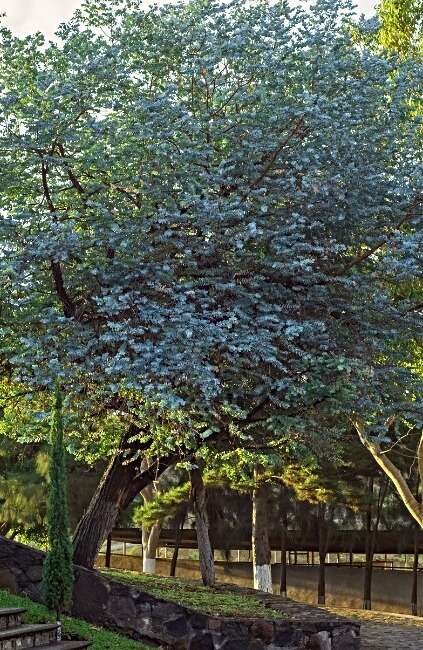
A spectacular species that sports silvery to ash-grey foliage and a lovely, rounded crown detailed in immaculate textures. The dense crown is low-growing, offering some of the best shade when looking at differenty species of eucalyptus.
- Native Area: Central NSW and Victoria
- Size: 6 to 15 metres tall, 6 to 12 metres wide
- Lifespan: Around 50 years
- Uses: Beautiful feature and shade tree
- Growing Conditions: Prefers full sun and enriched soil that retains good moisture.
- Maintenance: In cooler climates, protect from harsh winter frosts with a frost cover.
28. Rainbow Eucalyptus - Eucalyptus deglupta
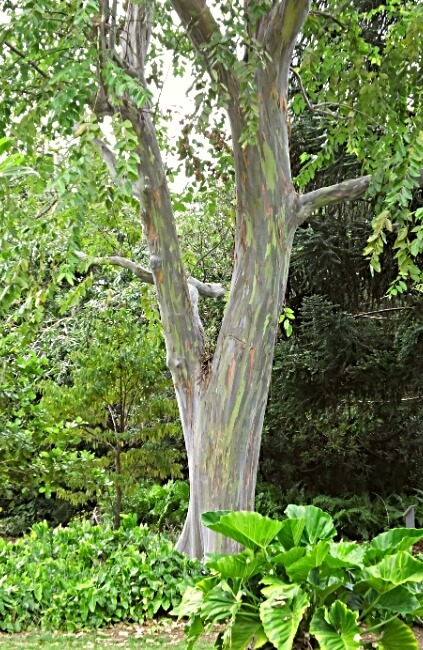
Perhaps one of the most beautiful native trees on this list, rainbow eucalyptus features a highly variegated bark that sports vivid stripes of greens, browns, reds, and yellows that extend across the entire tree.
Flowers are fluffy and white, borne in small groups on branches.
- Native Area: Widespread in Australia
- Size: Up to 60 metres tall and 30 metres wide
- Lifespan: 50 to 150 years
- Uses: Ornamental feature tree
- Growing Conditions: Needs full sun and fertile soil to grow properly.
- Maintenance: Requires regular waterings and tip pruning.
29. Bell-Fruited Mallee – Eucalyptus preissiana
Fluffy buttery yellow blooms sit gracefully in the vibrant foliage of Eucalyptus preissiana. This eucalyptus plant has a spreading habit and a multi-trunked form, perfect for filling out sparsely populated sections of the garden.
Its smaller growing habit is well suited to more manicured gardens that don’t have space for a large tree.
- Native Area: Western Australia
- Size: 2 to 5 metres tall and wide
- Lifespan: Up to 50 years
- Uses: Ornamental feature tree
- Growing Conditions: Grows well in sandy to free-draining clay and gravel soils and needs full sun.
- Maintenance: Fertilise bi-annually with a native slow-release fertiliser and water well.
30. Red-Capped Gum – Eucalyptus erythrocorys
A small tree or shrub with mallee habits, Eucalyptus erythrocorys has a more relaxed form with drooping foliage and a compact crown.
In spring, bright yellow fluffy flowers pop up all around the tree with branch tips decorated in pops of red clusters.
- Native Area: WA
- Size: 3 to 10 metres tall, 3 to 6 metres wide
- Lifespan: 30 to 50 years
- Uses: Showy feature tree or great for containers
- Growing Conditions: Prefers full sun and soils that are alkaline to slightly acidic.
- Maintenance: Prune to keep tidy and remove damaged branches.
Benefits of Growing Different Eucalyptus Plants
While there are many species of eucalyptus plant to choose from, most offer similar benefits to gardens. They are also all a part of the Myrtle (or Myrtaceae) family of plants, so many identifiable characteristics span across the entire family.
Here are some of the most common benefits of growing different eucalyptus plants:
- Eucalyptus species tolerate a wide range of growing conditions from dry heat to the cooler coastal regions
- Some species suit both indoors and outdoors
- Eucalypts have excellent soil improvement properties with the ability to release essential eucalyptus oils and nutrients into soil
- Many Eucalyptus species are adapted to our endemic conditions so they are typically fast-growing plants
- Their foliage offers lovely greenery and texture to outdoor spaces while their gorgeous canopies offer stunning silhouettes and shade
- There are numerous Eucalyptus species to choose from for any garden size and setting
- They make for excellent wildlife habitats and handsome stems can be cut at any time for use in floral arrangements
- Most species are evergreen trees, offering year-round appeal outdoors
Tips for Growing Different Types of Eucalyptus
While growing conditions and care can vary depending on which types of gum trees you grow, most species do share similar needs that will help them thrive and grow their best.
Here are some useful tips for growing different eucalyptus plant:
- Always use well-draining soil and avoid waterlogged soil for extended periods
- Eucalyptus trees and shrubs need plenty of sun to thrive and grow well – plant them in a position that gets at least 6 hours of direct sunlight daily
- Choose a species that is well-suited to your garden’s conditions and climateA good pruning routine can help ensure the health and longevity of your Eucalyptus plants – prune regularly in the dormant season in late winter to early spring and remove any dead or damaged branches as needed
- While most eucalypts are drought-tolerant to some degree, they do still require regular watering, especially during the hot summer months or dry periods – water deeply and consistently, allowing the soil to dry slightly between waterings
- Most eucalypts don’t require much fertilisation but if your soil is lacking in nutrients, you can add a slow-release fertiliser to your soil every few months
- Trees can benefit from regular mulching in summer to help retain soil moisture and prevent weeds – much with an organic mulch around the base of trees
- Saplings may need to be staked while young for support against strong winds
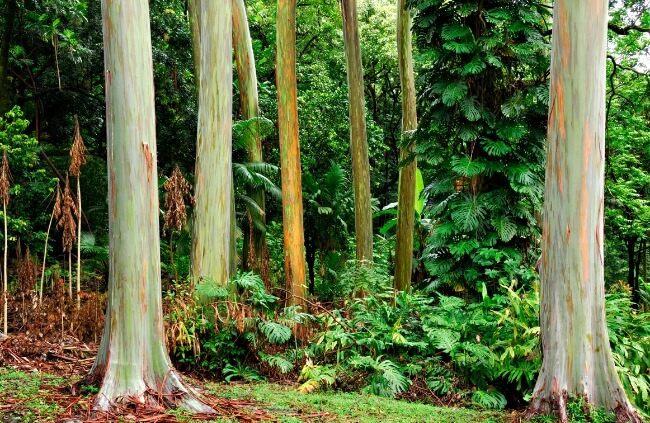
Frequently Asked Questions About Eucalyptus
How fast do eucalyptus trees grow?
Eucalyptus trees are some of the fastest growing tree species with many varieties reaching maturity as early as 10 years. Even small saplings have rapid growth rates. On average, a eucalyptus tree can grow anywhere between 2 and 5 metres per year in good conditions.
Where do most eucalyptus trees grow?
The Eucalyptus genus consists of over 700 species, most of which are native to Australia, where they are used as the primary food source of koalas, or used as firewood, timber, and for certain medicinal purposes.
Where are the tallest eucalyptus trees located in Australia?
Tasmania has some of the tallest, longest-living eucalyptus trees globally. A long-lived specimen called Centurion stands just over 100 metres tall in Tasmania.
Where do eucalyptus trees grow best?
Most types of gum trees thrive in a full sun position with at least 6 hours of healthy sunlight daily. They also need to be planted in well-drained soil, with some requiring protection from strong winds.
Can you keep eucalyptus small?
Each species will vary in growth rate but overall, several species like E. gunnii can be kept smaller as they respond well to pruning.
Do eucalyptus trees have deep roots?
These tall trees tend to have shallow and spreading root systems. While this may not pose an issue heading deeper into the soil, the shallower roots can pose a problem in home landscaping. Be sure to plant eucalypts far enough away from any buildings, structures, or paving, allowing adequate space for their canopies and roots.
Are eucalyptus leaves poisonous to dogs?
Yes, eucalyptus leaves are considered toxic to dogs. Fallen leaves will need to be regularly cleaned up if you have pets frequently roaming the garden.
Why do they call it a gum tree?
The common name for eucalyptus trees is gum trees, owing to the visible gummy sap they ooze from their trunks when the surface is damaged.
How do you propagate eucalyptus trees?
Eucalypts can be propagated in a variety of ways, but the most reliable methods include growing them from seeds or propagating them using stem cuttings.
What does eucalyptus attract?
The lovely aromatic leaves of eucalyptus will help to attract many introduced and native bees and other vital pollinators to your garden. The scent will also help to deter mosquitoes.
Elevate Your Garden Greenery with Different Types of Eucalyptus
So, there you have it, 30 gorgeous types of gum trees you can grow in Australia.
Whether for their aromatic foliage, textured canopies, or their longevity, gum trees are certainly a must-have addition to Australian gardens that have the space.
Take your garden's greenery and structural appeal to the next level with one of these stunning types of eucalyptus trees.
Published on December 18, 2023 by Nathan Schwartz
Last Updated on September 19, 2024


